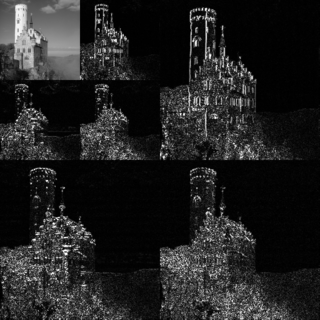Loading AI tools
From Wikipedia, the free encyclopedia
Cohen–Daubechies–Feauveau wavelets are a family of biorthogonal wavelets that was made popular by Ingrid Daubechies.[1][2] These are not the same as the orthogonal Daubechies wavelets, and also not very similar in shape and properties. However, their construction idea is the same.

The JPEG 2000 compression standard uses the biorthogonal Le Gall–Tabatabai (LGT) 5/3 wavelet (developed by D. Le Gall and Ali J. Tabatabai)[3][4][5] for lossless compression and a CDF 9/7 wavelet for lossy compression.
For every positive integer A there exists a unique polynomial of degree A − 1 satisfying the identity
This is the same polynomial as used in the construction of the Daubechies wavelets. But, instead of a spectral factorization, here we try to factor
where the factors are polynomials with real coefficients and constant coefficient 1. Then
and
form a biorthogonal pair of scaling sequences. d is some integer used to center the symmetric sequences at zero or to make the corresponding discrete filters causal.
Depending on the roots of , there may be up to different factorizations. A simple factorization is and , then the primary scaling function is the B-spline of order A − 1. For A = 1 one obtains the orthogonal Haar wavelet.

For A = 2 one obtains in this way the LeGall 5/3-wavelet:
| A | QA(X) | qprim(X) | qdual(X) | aprim(Z) | adual(Z) |
|---|---|---|---|---|---|
| 2 | 1 |
For A = 4 one obtains the 9/7-CDF-wavelet. One gets , this polynomial has exactly one real root, thus it is the product of a linear factor and a quadratic factor. The coefficient c, which is the inverse of the root, has an approximate value of −1.4603482098.
| A | QA(X) | qprim(X) | qdual(X) |
|---|---|---|---|
| 4 |
For the coefficients of the centered scaling and wavelet sequences one gets numerical values in an implementation–friendly form
| k | Analysis lowpass filter
(1/2 adual) |
Analysis highpass filter
(bdual) |
Synthesis lowpass filter
(aprim) |
Synthesis highpass filter
(1/2 bprim) |
|---|---|---|---|---|
| -4 | 0.026748757411 | 0 | 0 | 0.026748757411 |
| -3 | -0.016864118443 | 0.091271763114 | -0.091271763114 | 0.016864118443 |
| -2 | -0.078223266529 | -0.057543526229 | -0.057543526229 | -0.078223266529 |
| -1 | 0.266864118443 | -0.591271763114 | 0.591271763114 | -0.266864118443 |
| 0 | 0.602949018236 | 1.11508705 | 1.11508705 | 0.602949018236 |
| 1 | 0.266864118443 | -0.591271763114 | 0.591271763114 | -0.266864118443 |
| 2 | -0.078223266529 | -0.057543526229 | -0.057543526229 | -0.078223266529 |
| 3 | -0.016864118443 | 0.091271763114 | -0.091271763114 | 0.016864118443 |
| 4 | 0.026748757411 | 0 | 0 | 0.026748757411 |
There are two concurring numbering schemes for wavelets of the CDF family:
The first numbering was used in Daubechies' book Ten lectures on wavelets. Neither of this numbering is unique. The number of vanishing moments does not tell about the chosen factorization. A filter bank with filter sizes 7 and 9 can have 6 and 2 vanishing moments when using the trivial factorization, or 4 and 4 vanishing moments as it is the case for the JPEG 2000 wavelet. The same wavelet may therefore be referred to as "CDF 9/7" (based on the filter sizes) or "biorthogonal 4, 4" (based on the vanishing moments). Similarly, the same wavelet may therefore be referred to as "CDF 5/3" (based on the filter sizes) or "biorthogonal 2, 2" (based on the vanishing moments).
For the trivially factorized filterbanks a lifting decomposition can be explicitly given.[6]
Let be the number of smoothness factors in the B-spline lowpass filter, which shall be even.
Then define recursively
The lifting filters are
Conclusively, the interim results of the lifting are
which leads to
The filters and constitute the CDF-n,0 filterbank.
Now, let be odd.
Then define recursively
The lifting filters are
Conclusively, the interim results of the lifting are
which leads to
where we neglect the translation and the constant factor.
The filters and constitute the CDF-n,1 filterbank.
The Cohen–Daubechies–Feauveau wavelet and other biorthogonal wavelets have been used to compress fingerprint scans for the FBI.[7] A standard for compressing fingerprints in this way was developed by Tom Hopper (FBI), Jonathan Bradley (Los Alamos National Laboratory) and Chris Brislawn (Los Alamos National Laboratory).[7] By using wavelets, a compression ratio of around 20 to 1 can be achieved, meaning a 10 MB image could be reduced to as little as 500 kB while still passing recognition tests.[7]
Seamless Wikipedia browsing. On steroids.
Every time you click a link to Wikipedia, Wiktionary or Wikiquote in your browser's search results, it will show the modern Wikiwand interface.
Wikiwand extension is a five stars, simple, with minimum permission required to keep your browsing private, safe and transparent.